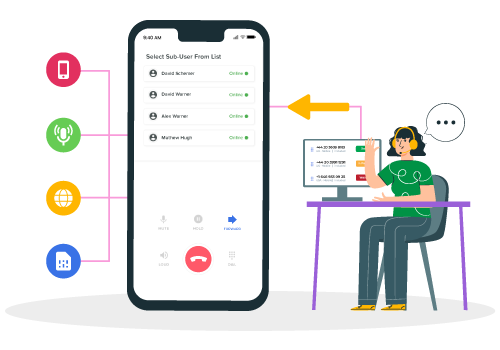Senior Writer: Sindhu Bharathi
Customer service agents typically handle a high volume of calls and tickets every day. It is only natural that customers would want a resolution to their problems the very first time. However, navigating every call to an appropriate agent without holding them for long has always remained challenging for businesses and call centers.
Without the right set of tools, it can lead to employee burnout on the one hand and customer dissatisfaction on the other. Automatic Call Distribution helps businesses set an order and automatically distribute incoming calls following the predetermined order. This helps businesses mitigate the challenges of handling multiple calls in a go.
This blog presents extensive information on the working, types, and benefits of Automatic Call Distribution. You will understand what is ACD, how does ACD work and other intricate details of the Automatic call distribution software.
Automatic call distribution is a must-have for efficient call management. It optimizes customer service by routing incoming calls to the most suitable agent, reducing wait times and improving overall productivity. Choose a system that integrates seamlessly with your business needs and has a user-friendly interface for maximum results.
What is ACD or Automatic Call Distribution?
Automatic Call Distribution is a telephony system that helps businesses and call centers automate the process of receiving and routing calls to the appropriate agent.
To do so, the Automatic Call Distribution systems follow a predetermined order. You can choose the order you want to route the calls, and the ACD will automatically distribute the incoming calls in that order. This makes it easy for businesses and acd contact centers to handle high volumes of incoming calls in an efficient manner.
Automated Call Distribution systems help enhance the quality of customer service by ensuring that they are connected to an appropriate agent in the shortest possible time span.
Why Should You Choose ACD Over IVR?
Even before the automatic call routing routes the callers to the agent, they must go through the IVR systems. Often, ACD and IVR systems are confused with each other. Let us look at the differences.
Interactive Voice Response (IVR) systems interact with callers and collect information from them by presenting choices and options through a menu. They respond through keypads or voice inputs. For example, an IVR system may ask you to ‘Press 1 if you want information about our services’. IVRs are primarily used to understand a caller’s request and decipher the kind of support they seek.

Based on the information and customer data collected by the IVR, ACD routes the calls and distributes them accordingly. IVR is more of a front-end tool that businesses deploy to interact with customers, while ACD helps connect callers with customer service agents at the back end.
IVR and ACD help businesses and contact centers enhance their productivity and achieve higher customer satisfaction.
What does ACD Mean in a Call Center?
An Automatic Call Distributor (ACD) is a telephony system commonly used in call centers and businesses that handle large volumes of inbound calls by efficiently routing them to an appropriate agent.
Following are the capabilities of an ACD call center software.

1. Route the Calls to Appropriate Agents
ACD helps route calls to the most appropriate agent based on predefined criteria, including skills, location, etc. In case the customer requests technical information; the ACD routes the call to the technical department.
2. Prioritize VIP Callers
Based on the pre-specified information, the ACD phone system identifies VIP callers and ensures they are directly routed to the appropriate agent. In case the agent is not available to answer the VIP caller, the ACD phone system places them in the front of the queue.
3. Call Monitoring and Reporting
The Automatic Call Distribution system allows managers and senior leaders to monitor calls and evaluate the agent’s response. The ACD phone system allows them to engage in call barging and whisper coaching. A HubSpot study shows that nearly 50% of customer service agents struggle when it comes to handling complex requests. Call monitoring and call barging helps businesses better train their employees and handle customer requests more effectively.
4. Data and Insights
The call center acd help businesses to gather important data about incoming calls. The data includes the total number of incoming calls, the average length of the calls, the waiting time, the agent’s response time, and so on. The insights derived from this data help managers enhance the overall efficiency of their communication system.
5. Call Queuing
With ACD, businesses can have multiple call queues. There can be different queues for different locations, departments, skills, etc. When the waiting queue is long, ACD gives callers an option to request a callback. It also directs them to voicemail when the queue is full, and the agent can no longer take the call.
The next section presents intricate details on how does ACD work.
How does ACD Work?
The working of the Automatic call distributor can be brought under the following three steps.
- Caller Identification
- Call Queuing
- Call Distribution and Routing
1. Caller Identification

When a customer contacts the call center or a customer service number in a business, they are greeted and presented with an IVR (Interactive Voice Response) menu. Based on the information provided by the caller, the system determines the purpose of the call. It also identifies other key factors like location, language, department, etc. The acd system call center distributes the call to the most qualified agent.
2. Call Queuing
The second step in call distribution is to add the callers to the queue and sort them accordingly. The position of a caller in the queue is based on several factors, including the nature of the query, waiting time, etc.
Most communication systems have an efficient call prioritization system to ensure that they prioritize and serve high-value customers. Apart from VIP prioritization, the ACDs can be programmed to identify and sort customers based on other factors like location, query, agent availability, waiting time, and so on.
3. Call Distribution and Routing
The final step in ACD’s functioning is to distribute and route the call, depending on your preference. In case you want the call to be routed to the most qualified agent, calls can be routed based on skill as an important criterion. On the other hand, if your call management objective is to minimize the waiting time and shorten the call queues, the Automatic call distributor system can be programmed to distribute the call to an immediately available agent.
Different Types of Call Distribution
When it comes to call distribution, there are different methods for businesses to follow and achieve their objective.

1. Rotary or Round-robin Method
The Rotary method is one of the simplest distribution methods. The inbound calls are routed in a fixed order, so call center agents endure an equal workload. If there are five agents in a department, the first caller is routed to the first agent, the second to the second agent, and so on. After the call has reached the fifth agent, the call is again routed to the first agent.
2. Linear or Fixed Order Distribution Method
In this method, the call center agents are sorted and arranged in a fixed order. The inbound calls are distributed to the first agent on the list. Calls are passed on to the next agent only when the previous agent in the list is busy or unavailable. This helps when you have customer service agents who are more skilled and experienced than others. They are naturally capable of handling queries more effectively than other customer service representatives on the list.
3. Simultaneous Distribution Method
In the simultaneous call distribution method, when there is an incoming call, it is routed to all agents at once. The very first agent who picks up the call will handle the request of the caller. This is the most appropriate acd call routing strategy when service speed matters to your business and you intend to reduce customer waiting time.

4. Talk-time Based Distribution
This is very similar to the round-robin routing strategy, where the workload is equally apportioned among all the customer service agents. The Automatic call distributor routes the call to the agent who has the least talk time. This way, the system ensures that all the agents in the system share an equal workload.
5. Skills-Based or Weighted Call Distribution
In weighted or skills-based routing methods, the Automatic Call Distribution prioritizes callers based on their skill assessment score. Language proficiency, fluency, technical expertise, experience, response time, etc., are some of the common automatic call distribution features considered to assess the skill of an agent.

Imagine you have 100 incoming calls and 5 agents available to handle them. If the first agent is assigned weights of 60%, second with 20%, third with 10%, fourth with 7% and fifth with 3%. The skill-based distribution policy assigns 60 of those 100 calls to the first, 20 to the second, 10 to the third, 7 to the fourth and 3 to the fifth.
6. Time-based Distribution Method
Time-based distribution method works on the basis of the availability of the agent to take the call. It routes the call only to agents who are available and in case there is no one to take the call, it routes the call to voicemail or offers a callback option.
What are the Benefits of ACD?
As the Automatic Call Distribution system offers customizable call distribution mechanisms and routing options, it helps handle employee burnout as well as improve the overall efficiency of the communication system. Following are some of the key benefits of using an Automatic Call Distribution (ACD) system.

1. Improves Customer Experience
Automated Call Distribution helps enhance customer experience by minimizing the customer wait time. Also, by following the appropriate call distribution mechanism, the ACD helps route the calls to the most qualified agent. This way, the call gets routed to the agent with the skills and expertise to handle the customer’s request effectively.
Also, automatic call distribution software can be programmed to prioritize calls from VIP and premium-grade customers that need immediate attention. This enhances overall customer satisfaction.
2. Enhances Workforce Productivity
An automatic call distributor is an important tool for workforce management. It ensures that all agents in the customer service department share an equal amount of work. This reduces agent burnout, minimizes idle time, and improves the overall productivity of the workforce.
3. Resource Optimization
Automatic call distribution system collects essential data about the average waiting time, agent response time, number of calls, etc. This helps businesses allocate resources in an efficient manner to reduce agent burnout and enhance customer service, which in turn promotes workforce management.
4. Monitoring and Coaching
ACD helps senior leaders and managers monitor the performance of their agents in real time. This way, they can ensure that incoming calls and customer requests are handled effectively. Periodic assessment of skills helps agents identify room for improvement.
Why DialerHQ is the Perfect ACD System for Your Workplace
Given the intensity of competition in this rapidly evolving world, offering quality customer service helps businesses stand ahead of their counterparts. For instance, a study conducted by American Express shows that businesses in the USA lose an average annual revenue of $62 billion owing to poor quality in customer service.

The benefits listed in the previous section help businesses enhance the effectiveness of their customer service. The DialerHQ is an effective ACD platform and it has extensive features that make it the one of the most sought-after communication platform.
1. Automatic Call Distribution
The Automatic Call Distribution feature of DialerHQ helps businesses automate the process of distributing the incoming calls to an agent following a pre-determined order and routing strategy.
2. Interactive Voice Response System
DialerHQ has an IVR system that interacts with callers and greets them accordingly. It has pre-recorded menu options and navigates callers based on their response to the menu.
3. Call Queuing
DialerHQ has a call queuing feature that helps businesses place their callers in the queue unless a right agent is available to handle the customer request. This feature reduces the hold time and aids businesses with effective call transfers.
4. Call Forwarding
The call forwarding feature of DialerHQ helps businesses redirect the incoming calls to a phone number or voicemail depending on the availability of the agent.
5. Call Monitoring
DialerHQ has call monitoring options using which managers and senior leaders can monitor, barge, and do whisper coaching. This way, businesses can make sure that customer requests are handled effectively.
If you are looking for an efficient acd system call center, then DialerHQ is your go-to platform.
Wrapping Up
As we have finally reached the end of this extensive yet helpful guide, we hope you have a better understanding of modern call center operations and call center AI now. You must carefully analyze your processes to determine which tasks an AI can cater to better while maximizing profit and reducing manual efforts.
Don’t forget to check out your contact center’s features to ensure they match your business needs well. Now that you’re appropriately armed with the required knowledge to select the best AI for contact center, go ahead and adopt one today!
Frequently Asked Questions
ACD stands for Automatic Call Distribution. ACD systems help businesses automate the process of routing inbound calls to an appropriate agent. ACD systems businesses minimize employee burnout as well as enhance customer satisfaction.
CD technology helps call centers and businesses manage a high volume of incoming calls while minimizing employee burnout. In addition, this helps direct customer calls to agents who are best equipped to handle the call.
For small businesses with a handful of agents, ACD systems help manage large call volumes. In industries like healthcare, hospitality, Edtech, etc. where businesses ought to handle a high volume of calls at each step of the process, from service inquiry to billing, ACD systems prove to be effective and advantageous.
PBX stands for Private Branch Exchange and allows employees to make and receive calls. ACD stands for Automatic Call Distribution, and it helps contact centers and businesses distribute and route incoming customer calls.
Sindhu Bharathi is an inquisitive learner and prolific B2B/SaaS writer with experience of working in diverse industries. She has a demonstrated history of delivering well-researched, original content. From generating long-form articles, blogs, and white papers to social media copies, she pivots her skills to resonate with the medium and deliver compelling content that has the power to captivate the audience.
Updated : March 28, 2024

Subscribe to our newsletter & never miss our latest news and promotions.





